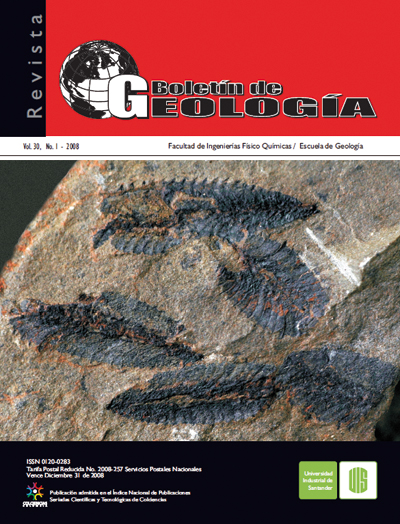RELACIONES EMPÍRICAS ENTRE PARÁMETROS INSTRUMENTALES Y MACROSÍSMICOS DE ALGUNOS TERREMOTOS FUERTES DE COLOMBIA
How to Cite
Abstract
In order to establish the relationships between macroseismic and instrumental parameters, macroseismic feld of 28 historical earthquakes that produced great effects in the Colombian territory were studied. The integration of the parameters was made by using the methodology of Kaussel and Ramirez (1992), for great Chilean earthquakes; Kanamori and Anderson (1975) and Coppersmith and Well (1994) for world-wide earthquakes. Once determined the macroseismic and instrumental parameters it was come to establish the model of the source of each earthquake, with which the data base of these parameters was completed. For each earthquake parameters related to the local and normal macroseismic epicenter were complemented, depth of the local and normal center, horizontal extension of both centers, vertical extension of the normal center, model of the source, area of rupture. The obtained empirical relations from linear equations, even show behaviors very similar to the found ones by other authors for other regions of the world and to world-wide level. The results of this work allow establishing that certain mutual non compatibility exists between the area of rupture and the length of rupture determined by the macroseismic methods, with parameters found with instrumental data like seismic moment, Ms magnitude and Mw magnitude.
Keywords: Empirical relations, earthquakes, macroseismic feld, magnitude, Colombia.
Downloads
References
CERESIS 1985. Catálogo de Terremotos para América del Sur. Centro Regional de Sismología Para América del Sur. 1-14.
Gutemberg, B. y Richter, C.F. 1956. Earthquake magnitude, intensity, energy and acceleration, Bull. Seismol. Soc. Am., 46: 105-145.
Hanks, T.C. y Johnston, A.C. 1992. Common features of the excitation and propagation of strong ground motion for North American earthquakes, Bull. Seism. Soc. Am., 82: 1-23
Kanamori, H. y Anderson, D. 1975. Theoretical Basics of Some Empirical Relations in Seismology, Bulletin of the Seismological Society of America, 65(65): 1073 – 1095
Kaussel, E. y Ramírez, D. 1992. Relaciones entre parámetros focales y macrosísmicos de grandes terremotos chilenos. revista geofísica, instituto panamericano de geografía e historia, (37): 159-193. julio – diciembre.
Marín, J. P. 1999. Campo Regional Macrosísmico de Algunos Sismos Históricos y Algunas Relaciones con Datos instrumentales. Tesis de maestría en Ingeniería Sísmica. Universidad de los Andes. Bogotá, Colombia. 102p
Mora, H. 1995. Central and South America GPS Geodesy: Relative plate motions determined from 1991 and 1994 measurements in Colombia, Costa Rica, Ecuador, Panama and Venezuela, MSc Thesis, University of South Carolina.
Ramírez, J. E. 1975. El terremoto de Cúcuta cien años después. Edit. Desarrollo, Bogotá:Shebalin, N. V. 1974. Focos de Terremotos Fuertes en el Territorio de la URSS. Moscú. Nauka: 52. [En Ruso].
Singh, S. K., Bazan, E. y Esteva, L. 1980. Expected earthquake magnitude from a fault. Bulletin of the Seismological Society of America; June 1980; 70(3): 903-914
